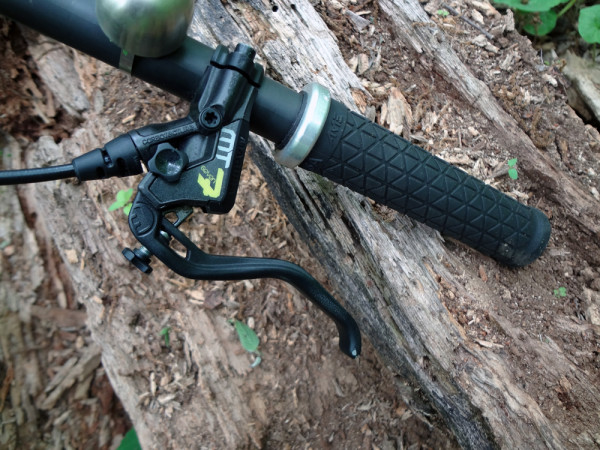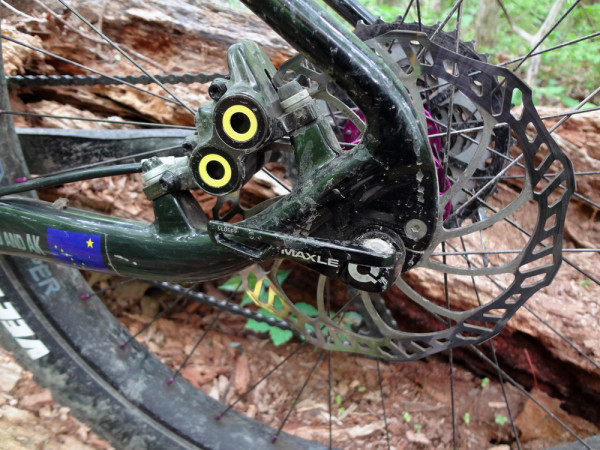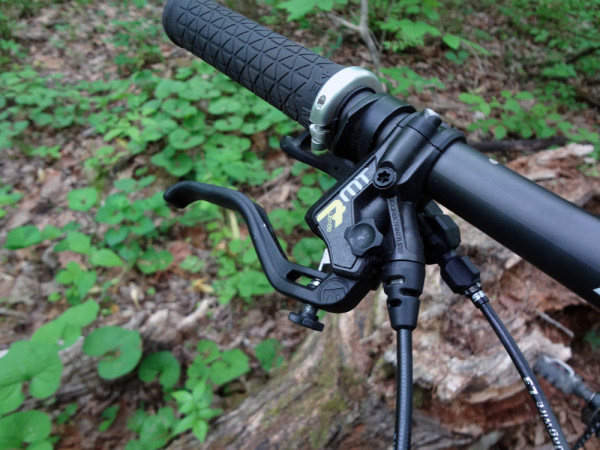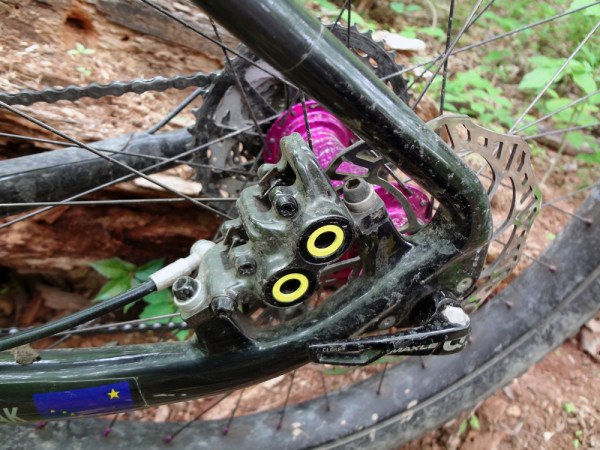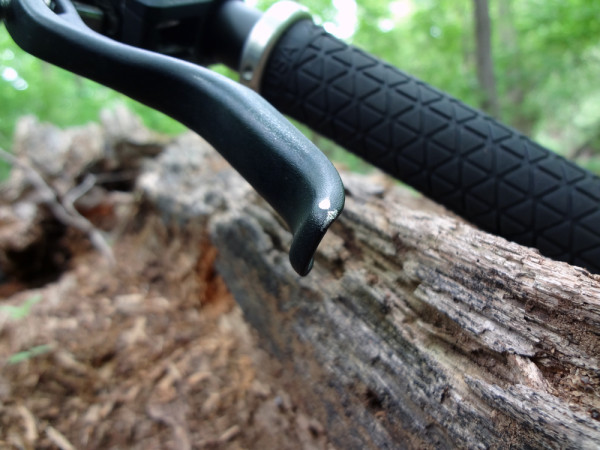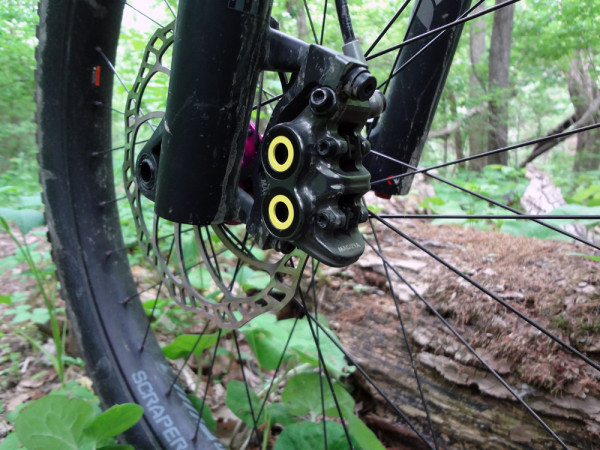It’s been a while since the Gustav M was the heavy weight king of the Magura line up. Since then that top spot has been taken by a new comer, the four piston MT7. While still offering massive amounts of power, the MT7 sets itself apart with a lightweight build that somewhat hides its heavyweight punch. On one hand the MT7s are light enough to find a home on enduro rigs but are powerful enough to stop full on DH bikes.
After living with them for a few seasons, the MT7s were a surprising fit for a completely different kind of bike as well…
Borrowing from their moto development the four piston caliper is the source of the brake’s power. Forged in a single piece to mimic the same shape as their supermoto caliper, the brake houses four pistons with 4 individual brake pads. As we were told during the brake’s initial release, the leading edge of the brake pad provides most of the brake’s power so increasing the number of leading edges effectively increases the stopping power. The MT5 brake uses the same piston layout but uses two pads instead of four, though the friction material is split into two on each pad.

With most of the weight centered at the caliper, the brakes are mated to a Carbotecture SL body with an aluminum lever which helps keep the weight down to 268g for the complete assembly (with full length hose) minus rotor, adapter, and rotor hardware. For the complete breakdown on actual weights make sure to check out our first impressions on the MT7. Compare that to something like the Avid X0 Trail front brake we tested (with a shortened hose and no bar clamp) at 206g, and the MT7 is heavier but not by much.
Installation:
Overall, the process of installing the MT7s was fairly straight forward but there are a few things to point out. First, depending on the positioning of your rear brake in the frame and the frame itself you may find yourself wanting to switch to Allen bolts over the included Torx bolts. Basically, tightening the rear bolt is a major pain since whatever Torx wrench you try only allows about a quarter turn before you have to reposition the wrench. This isn’t a Magura specific problem as it happens with any company using Torx fittings for their brake calipers and only presents itself as an issue when the caliper is tucked inside the rear stays. Allen bolts allow you to use a wrench with a ball end on the rear so you can tilt it to clear the seat stay. The design of a Torx bolt won’t let you do that so it either requires a specialized tool, or the patience of a saint as you continually reposition the wrench. I’m a fan of the Torx fitting in many situations, just not this one.
The other thing to consider is the brake mount itself. Due to the extra long pad wrap of the MT7 caliper, any misalignment of the caliper is exaggerated resulting in the possibility of a rubbing brake. When mounted to a Turner Burner for Enduro testing the caliper bolted up without issue and was easily adjusted. But when I went to install it on my Borealis Echo the rear post mounts weren’t quite faced properly which resulted in the pads just barely rubbing. Unfortunately, since we don’t have access to a 197 x 12 compatible brake mount facer (does one even exist yet?) it required some hand work with a file to get the brake to be quiet. Again, this was no fault of Magura’s, but the longer contact patch of the pads will make inconsistencies like this more noticeable.
After cutting the lines down to appropriate lengths, bleeding the brakes was easy enough following Magura’s video instructions – though I will say the syringes from something like the Jagwire Mineral Oil Pro Bleed Kit make the job much easier. Since the initial bleed the brakes have been perfect. However if the brake would start to leak the would be covered by Magura’s 5 year leak proof guarantee for brake levers and cylinders.
Durability:
If there is a weak point of the Magura MT7s you would think it would have to be the lever. But after a full season and two different bikes, the MT7s have proven themselves to be as, or even more durable than other brakes, levers included. Between many crashes including one in particular over a wooden feature that ended up with the brake lever pinned between two logs, and one bike falling off a moving vehicle (don’t ask), short of a few scrapes the brake levers are no worse for wear. After that crash on the wooden feature one of the brake levers did end up bent, but I was able to straighten it with some trail-side ingenuity and to this day you can barely tell it was ever tweaked. Also the fact that it bent instead of breaking off from the lever body is a big plus in my eyes.
When it comes to pad wear, you can tell the brakes have been used but there is still quite a bit of friction material left even after a full winter on a fat bike. Yes, I put this monster of a brake on my fat bike, but as it turns out that’s not nearly as odd as it sounds. Depending on how you choose to ride your fat or plus sized bikes, all that extra rotating weight can really benefit from powerful brakes especially if you find yourself riding trails with any sustained downhills. As it turns out, the MT7 is also the most temperature stable brake I’ve ever used, providing consistent performance down to about -12ºf this winter. No squeaks, no loss of brake pressure, or pumping up. Just constant performance regardless of the conditions. That was as cold as it got around here or I would have tested it to even lower temperatures. Even after riding through a rushing creek at 20ºf (we have some weird weather patterns) the completely frozen over brakes quickly melted through the ice and went on with trouble free braking. The large lever blades add even more reason to love the MT7 for fat bike usage as they work great with bulky gloves.
Ultimately, we expected the MT7s to be a great choice for Enduro to DH bikes, and they have proven that to be the case. Mounting them up to a fat bike to continue their testing over winter was a pleasant surprise and just proved to be an added bonus for an already great brake.
Performance:
While Magura has apparently gotten varied feedback on the bite point on the lever, I found the set up using the tool-less adjustment to be just about perfect when the lever was pushed in far enough to allow one finger braking. Otherwise the brakes can be set up to facilitate two finger braking if that’s your preference. As with almost every brake we’ve tested with a bite point adjustment, it went unused.
Really the only area we can fault the MT7 is in the noise department with a bit of grinding under heavy braking. Our test brakes were set up with the lighter and sharper Storm SL rotors so it is entirely possible the standard Storm rotors that are drilled rather than slotted would result in a quieter set up. There is also the fact that these brakes have seen a lot of road salt, ice, slush, mud, and ocean water by this point so the pads have been through the ringer. Otherwise the brake refuse to squeal or make any other annoying noises.
Overall, the MT7 has been a consistent performer that provides a huge amount of usable power. Modulation for the MT7 is on point and will give you the control to start pulling stoppies like Bernard Kerr. Ok, maybe not exactly like Kerr, but they do make it very easy to find that point between just enough stopping power and TOO MUCH! The Magura MT7s prove to be a versatile brake that should be a great match for most riders looking for controllable power. And now that there’s a limited edition RaceLine yellow version – what’s not to love?
Product Details:
- Weight – 268g (complete brake assembly and uncut 2000mm hose)
- Rotor – Storm or Storm SL, Sold separately, 160, 180, 203mm
- Lever body – Radial Carbotecture carbon flip flop design with EBT, two finger lever
- Royal Blood Mineral oil fill
- MagnetiX Brake pad system
- $319 per brake
- 5 Year Leak Proof Gurantee
